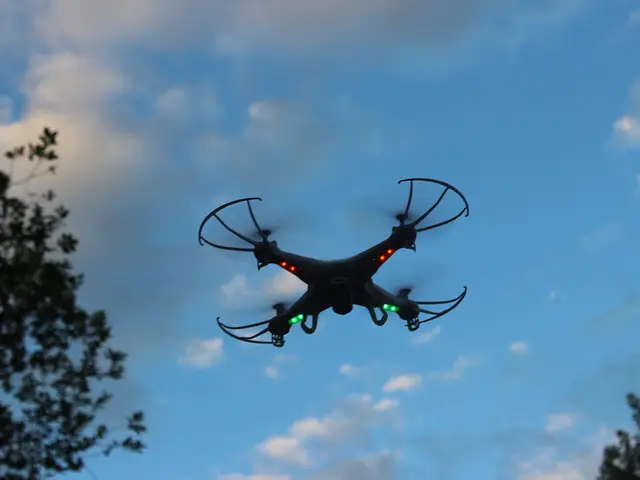AI and Machine Learning in the Air Force's Electromagnetic Spectrum Warfare: Not Quite There Yet, But Shaping Up
Artificial Intelligence's Potential Restrictions in Electronic Warfare, According to the Leading Military Officer
The future of AI and machine learning (AI/ML) is looking promising for the Air Force's radio frequency warriors, as they face off against America's adversaries in the electromagnetic spectrum. But don't pop the champagne just yet, as we're still some way off, according to Col. Larry Fenner Jr., the commanding officer of the 350th Spectrum Warfare Wing.
Speaking at the AFA's Mitchell Institute for Aerospace Studies inaugural Airpower Futures Forum, Fenner drew attention to the concept of cognitive electronic warfare (EW). In this context, cognitive EW refers to the use of AI/ML to automate time-consuming and labor-intensive manual tasks involved in processing and analyzing spectrum data collected by aircraft during missions. The ultimate goal is to transform this data into actionable intelligence that can be used to engineer electronic countermeasures or protective measures.
"We haven't got a component on an aircraft that can...do everything that we [currently] have to do [in the] rear echelon on the fly. That's ideal, but we're not there," Fenner admitted.
The current battleground for AI/ML in EW lies in the data architecture, Fenner explained. The potential lies in automating anomaly detection, allowing engineers to quickly home in on the target signal for further analysis and the production of defensive techniques or countermeasures. This would be a game-changer, as it would allow for rapid scaling up of capabilities, particularly in a high-end electromagnetic spectrum conflict with a peer adversary.
All this processing would take place in the rear echelon, but this could prove problematic in the vast Pacific theater, where China would be attempting to sever communication lines of U.S. forces. In the Indo-Pacific, Fenner raised the issue of the "tyranny of distance," particularly when it comes to data wrangling and ensuring data is transmitted back from the forward edge for analysis, exploitation, and re-engineering to be fed back to the warfighters.
Technological barriers and difficulties will need to be addressed in order to succeed. These include funding, resources, infrastructure, and personnel issues, some of which are man-made and some policy-made. Standardization is another challenge, given the wing supplies EMS data to more than 75 different platforms, each with dissimilar structures that can cause compatibility issues.
2021 saw the activation of the 350th SWW, which was seen as an attempt to refocus the Air Force enterprise on electromagnetic spectrum operations (EMSO). EMSO encompasses intelligence gathering, spectrum management, and traditional offensive and defensive EW. This focus is crucial given the relative neglect of EMSO during the war on terror, during which U.S. adversaries have had ample opportunity to counter traditional superiority in the spectrum.
The stakes are high, as Fenner argued, "If we lose in the spectrum, we lose in the air." This echoes comments made by senior Air Force officials, underscoring the critical importance of electromagnetic spectrum dominance.
Remember, this is just the tip of the iceberg when it comes to the role and future of AI/ML in cognitive EW. There's still a lot of work to be done, but the potential benefits for the Air Force are undeniable.
Insight:The Department of Defense is developing an open standard hardware/software platform known as CMOSS (C5ISR Modular Open Suite of Standards). This platform aims to integrate various capabilities, including electronic warfare, communications, and signals intelligence. This could potentially leverage AI/ML to enhance automated ECMs and protective measures.
Companies like HII are advancing AI and ML in defense, including areas relevant to electronic spectrum operations. The development and implementation of such technologies will play a significant role in shaping the future of AI/ML in cognitive EW.
The Air Force Materiel Command (AFMC) has engaged industry partners to develop strategies for digital warfighting and AI integration, suggesting a focus on leveraging AI for advanced spectrum operations. This collaboration will drive innovation and efficiency in electronic warfare capabilities.
Overcoming traditional tradeoffs in system design, such as size, weight, power, and cost (SWaP-C), will be fundamental to enhancing electronic warfare capabilities. AI is enabling the creation of smaller, faster, and more capable systems.
In summary, there is significant progress being made in the integration of AI and machine learning for advanced spectrum operations. However, challenges related to integration, testing, and spectrum management remain critical to address to ensure continued success in cognitive electronic warfare.
- The use of artificial intelligence and machine learning (AI/ML) in the Department of Defense's open standard hardware/software platform, CMOSS, potentially enhances automated electronic countermeasures and protective measures, especially in the realm of cognitive electronic warfare.
- Companies like HII are actively advancing AI and ML, particularly in areas relevant to electronic spectrum operations, which will likely significantly impact the future of cognitive electronic warfare.
- The Air Force Materiel Command (AFMC) is collaborating with industry partners to develop strategies for digital warfighting and AI integration, focusing on leveraging AI for advanced spectrum operations, thereby driving innovation and efficiency in electronic warfare capabilities.








